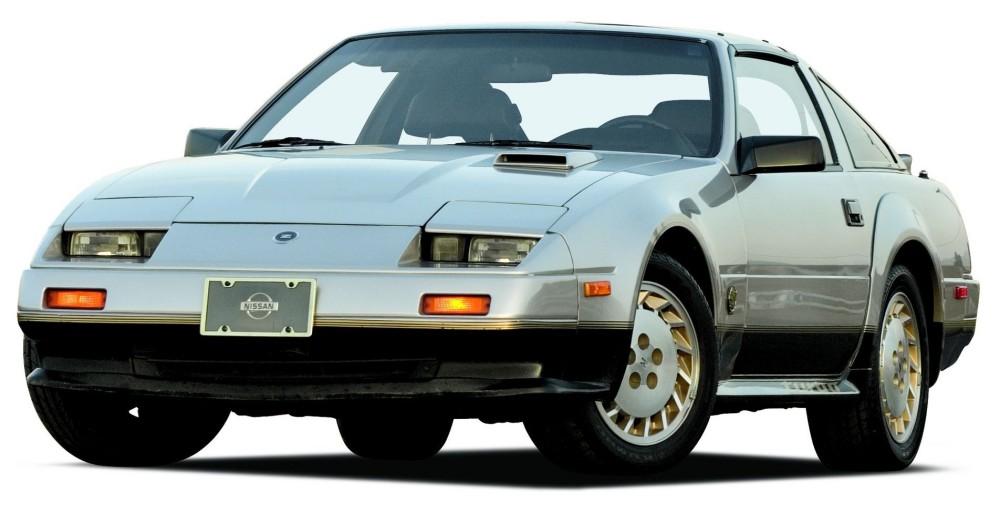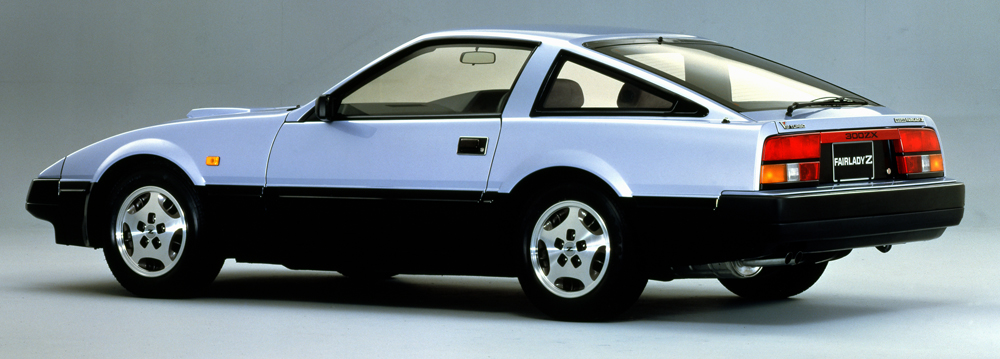
Sold on the Japanese market from 1983 through 2000 and in the United States from 1984 through 1996, the 300ZX name followed the numerical convention initiated with the 240Z, put forth by Yutaka Katayama, the one time president of Nissan Motors USA. The “X” designation had debuted with the previous generation Z car, the 280ZX, to signify the presence of luxury and comfort oriented features. The Z31 model of 1983 through 1989 was the more popular model, with over 100,000 more units sold than the Z32.
In 1984, Z® engine displacement increased again, with a 3.0-liter V6 replacing the classic Z® inline-6, and the 300ZX was born. Also, a specially equipped model celebrating the company?s 50th anniversary and priced at $25,999 was introduced. The 1984 Z® was the best selling sports car in America.
Nissan manufactured two special Z31 models. The 1984 300ZX 50th Anniversary Edition, released to celebrate Nissan’s half-century, was a fully loaded turbocharged model with a Silver/Black color scheme. All 50th Anniversary Edition came equipped with a digital dash including MPG and compass readouts, in-car electronic adjustable shocks, Bodysonic speakers in the seats, cruise and radio controls in the steering wheel, mirrored t-tops, embroidered leather seats, embroidered floor mats, sixteen-inch (406 mm) aluminum wheels, rear fender flares, different front fenders, and 50th AE logo badges on the body.
The only option available to the 50th Anniversary Edition was the choice between an automatic or a 5-speed manual transmission. 5,148 AE models were produced for the US market. Notably, 1984 also marks the last year of turbochargers cooled entirely by oil. 1985 turbo models are equipped with coolant passages to ensure turbo longevity.


No.236 Fairlady Z 200ZG (1985 : GZ31)
The third-generation Z (Z31) was launched in 1983, the same year as the Fairlady production total passed 1 million units. Unlike the 2.8-liter, the 3.0-liter model was the first in Japan to use a V6 turbo engine and attracted much interest. Its beautiful silhouette, boasting a drag coefficient (Cd) of 0.31, and its unique parallel-rising headlights were very popular.
- Overall…………………4,535 length /1,690 width /1,310mm height
- Wheelbase……………2,520mm
- Tread (front/rear)…1,415/1,435mm
- Curb weight………….1,270kg
- Engine…………………VG20E (V6, OHC), 1,998cc
- Max. power………….125kW (170PS)/6,000rpm
- Max. torque………….216Nm (22kgm)/3,600rpm
- Transmission………..5-speed MT, floor shift
- Suspension……………Strut, semi trailing-arm
- Brakes (front, rear)..Ventilated disc, disc
- Tires……………………..215/60R14 (front & rear)



The Z31 body was slightly restyled in 1986 with the addition of side skirts, fender flares, and sixteen inch (406 mm) wheels (all directly from the 1984 50th Anniversary Edition with the exception of the fender flares). Many black plastic trim pieces were also painted to match the body color, and the hood scoop was removed to provide a sleeker look. The car was given a final makeover in 1987 that included more aerodynamic bumpers, fog lamps within the front air dam, and 9004 bulb-based headlamps that replaced the outdated sealed beam headlights. The 300ZX-titled reflector in the rear was updated to a narrow set of tail lights running the entire width of the car and an LED third brake light on top of the rear hatch. The Z31 continued selling until 1989, more than any other Z-Car at the time. Over 70,000 units were sold in 1985 alone. Cars produced from 1984-1986 are referred to as “Zenki” models, while cars produced from 1987-1989 are known as “Kouki” models signifying the change in body styling.
The new V6 (2960 cc) Single overhead cam engine was available as a naturally aspirated VG30E or a turbocharged VG30ET producing 160 hp (119 kW) and 200 hp (150 kW) respectively. The engine was either a type A or type B sub-designation from 1984 to March 1987, while models from April 1987 to 1989 had a W sub-designation. The W-series engines featured redesigned water jackets for additional cooling, and fully floating piston wrist pins. The 1984 to 1987 turbo models featured a Garrett T3 turbocharger with a 7.8:1 compression ratio, whereas 1988 to 1989 models featured a low inertia T25 turbocharger with an increased 8.3:1 compression ratio and slightly more power—165 hp naturally aspirated and 205 hp (153 kW) turbocharged. Finally, these engines were equipped with self-adjusting hydraulic valve lifters. The transmissions were a 5-speed manual or an optional 4-speed automatic (contrary to popular belief, all Z31 automatics were the E4N71B equipped with torque-converter lockup INCLUDING turbo models.) All Z31’s were equipped with a Nissan R200 rear differential, April 1987 and later turbo models received an R200 clutch limited-slip differential except 1988 Shiro Special’s which had a Viscous-type limited slip. There were three trim models available: SF, GL and GLL. The SF model was only available in Canada.

In 1988, the turbocharged Shiro Special debuted with pearl white paint, stiffer springs and matched shocks, heavy-duty anti-sway bars, a unique front air dam, paint matched wheels, Recaro seats with matching door panels, painted bumperettes, white painted doorhandles and a viscous limited-slip differential. No options were available for the Shiro, meaning all Shiros were identical. It was the fastest car out of Japan, capable of 153 mph (246 km/h) speeds, as tested by Motor Trend with the electronic speed limiter disabled.
A total of 1002 Shiro Special Z31s were produced for the US market between January and March 1988.

You must be logged in to post a comment.